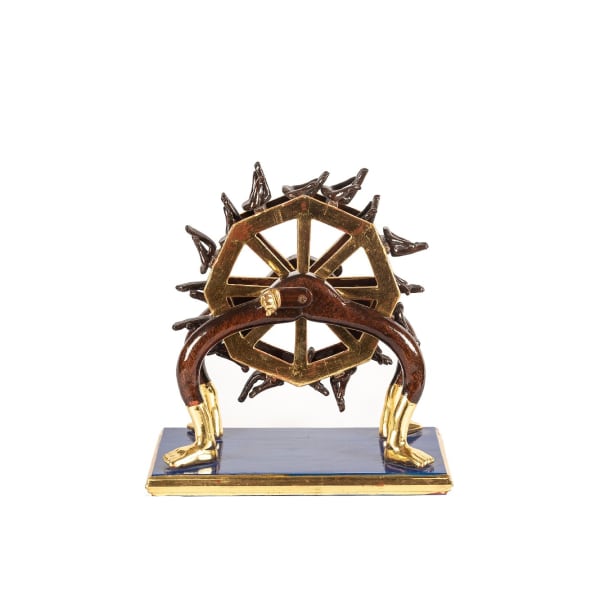-
Pedro Friedeberg: Something Like That!
-
Ruiz-Healy Art is pleased to present Pedro Friedeberg: Something like that! The exhibition marks the artist’s third solo gallery exhibition but the first at our New York City location. It is also his first New York City solo exhibit in over two decades and includes paintings, sculptures, and objects that provide insight into the artist’s singular vision.
Pedro Friedeberg is one of the most widely celebrated living artists in Mexico. Born in 1936, he has maintained a prolific and remarkable artistic practice for the last sixty years, and his influence can be felt across generations of artists. While he is best known for his iconic Hand Chair (first designed in 1962), Friedeberg’s work extends beyond furniture and design to visually intricate paintings, drawings, and sculptures. These works point to the elegant precision, irreverence, and iconoclasm that have garnered him cult-like status outside of Mexico; and in recent years, the long overdue critical recognition as one of the most significant artists in Latin America. Over the course of his six-decade career, Friedeberg has developed a formal universe that brings together various iconographies and influences from Op Art, Surrealism, Pop Art, and architectural design to religious symbology evoking Catholicism, Hinduism, Aztec codices, and signs of the occult.
-
First studying architecture, Friedeberg shifted to art with the encouragement of his mentor Mathias Goeritz, a post-war artist and art professor who was critical in bringing Mexico to the larger international art world. Friedeberg soon became part of a legendary group of Surrealist artists including Leonora Carrington and Remedios Varo, known for rejecting the social and political art dominant at the time. With their influence and the influx of Pop Art in the 1960s, Friedeberg’s work is often absurdist in tone, critiquing high/low cultural hierarchies. In this way, Friedeberg’s objects such as his signature Hand Chair and Butterfly Chair are perfect amalgams of the fantastical with the everyday. On view alongside his sculpture and design objects are the artist’s rarely exhibited paintings, which to some extent, have been overshadowed by the success of his furniture designs. These works play a key role in Friedeberg’s multidisciplinary practice: the densely patterned compositions—with their intricate architectural spaces, ideograms, and repeating visual systems—create layers of meaning within each image.
-
The new paintings in Pedro Friedeberg: Something like that! were conceptualized in 2020, during a time of global uncertainty and upheaval as the Coronavirus pandemic spread. The paintings partly reflect this altered reality and reveal a new energy visible in works like Crítica de la banalidad circunstancial teórica de la infraestructura a corto y mediano plazo de las odas y homenajes a las libertades geométricas, and the titular painting, Algo así (Something like That). These compositions embody Friedeberg’s renewed attention towards fine detail and color, while referencing pop culture, history, architecture, and text, creating complex topographies that speak to Friedeberg’s pastiche approach of marrying wide-ranging cultures and interests into his work.
-
“To a significant degree, the question of meaning in Friedeberg’s work seems to hinge directly on the accumulation of separate details that each seem anchored to different orders of signification. A dream-logic holds the different elements together, by hinting at an oblique order that remains elusive to the conscious mind. The visual experience is somewhat akin to deciphering a rebus or set of hieroglyphics: one’s own subjective sense of visual form and narrative determines the sequencing without any overt interference from the conscious mind.”
- Dan Cameron, "The Illusionist," Pedro Friedeberg: Praise of Folly, Ruiz-Healy Art, 2016.
-
 Pedro FriedebergVientos alisios, 2020Ink and acrylic on museum board40 x 47.50 in
Pedro FriedebergVientos alisios, 2020Ink and acrylic on museum board40 x 47.50 in
101 x 121 cm -
"It isn’t that Friedeberg has been ahead of his time, as most artists devoutly wish they could be, but that his work actually confounds time in the linear sense. By dipping with equal vigor into both the prehistoric and post-modern, Friedeberg transcends the conventional order of time, operating beyond its boundaries while the rest of us are trapped inside the flat, primitive structure of each day, each year, each era, drudgingly and obediently following the next."
- Dan Cameron, "The Illusionist," Pedro Friedeberg: Praise of Folly, Ruiz-Healy Art, 2016.
-
-
About the Artist
Pedro Friedeberg: Something Like That!: New York City
Past viewing_room























